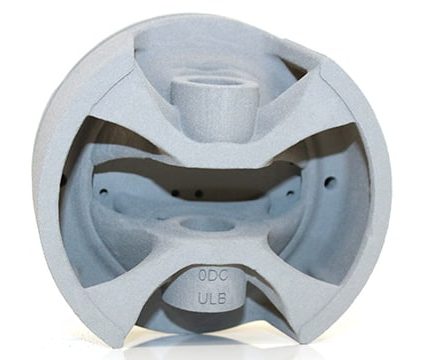GE Additive has been working to offer an industrial Binder Jet production solution to delivers quality parts at cost, at scale. The company is reporting that product development is on track and that it will launch its solution in the second half of 2021. As Desktop Metal and ExOne have joined forces, that ball is now in GE Additive’s (and HP 3D Printing’s) court to show what they can do. In spite of COVID-19 travel restrictions, the upcoming Formnext may be the ideal venue for a showdown.
When bringing a new product to market, it is of utmost importance for GE Additive to tangibly and immediately demonstrate a positive business impact for its customers. The Binder Jet solution has now been deemed to be reliable, safe and engineered to meet customers’ needs right away and in the future.
Since day one, the GE Additive Binder Jet development team has been working with partners such as Cummins (implementing a full production line), Sandvik (part of the Binder Jet beta program), Wabtec (one of the first adopters) and others, all of whom have been working together with GE to develop business cases, product roadmaps, applications and parts. It is important to these partners that the solution is mature, scalable, fit for its purpose and complete.
Customer-Centric Innovation
GE’s Binder Jet Line activates new potential for industrial scaled manufacturing so adopters can control real-time adjustments and improvements. This free-form manufacturing technology enables higher accuracy levels on intricate shapes and geometries with higher speed and flexibility. This results in a complete, configurable ecosystem of production hardware, software and GE’s AddWorks consultant engineers to bring an application from concept to production.
Manufacturing on Demand

By working with GE and its binder jetting technology customers can industrialize metal additive production for automotive and industrial parts in less time and less cost than by going at it alone. They are able to leverage the company’s deep materials knowledge and process pedigree from the experience with GE Aviation, Power and Healthcare to accelerate the implementation of additive production in any area of expertise.
H2 coming in H2
GE is promising that its production Binder Jet solution will be able to repeatably and reliably produce component geometries in the required material with the required tolerances, surface finish and material properties. It will also be able to be integrated into an automated workflow that includes de-powdering intricate parts without destroying fine features, then sintering the parts within the desired tolerances.
The total cost of ownership ($/cc) from powder to part in-hand will be, according to GE Additive, the ultimate driver of its Binder Jet technology. The company’s goal is to make industrial metal additive manufacturing an economical process for everyone. By driving down the cost of a final part, GE expects to open up new application spaces and enable agile innovation for the industry.
Thus, the Binder Jet Line has been designed to operate safely at scale. Systems minimize operator contact with machines and materials. GE’s Binder Jet technology can be integrated into reconfigurable factory cells and is automation-ready, with the company actively working to enable 20, 40, 100+ machine installations for true industrial production.
You might also like:
MVP releases new RAM 48 system for thermoset materials: Since the launch of the RAM system in 2019, MVP has discovered new applications for this technology, and it designed RAM 48 to complement its original RAM 816 model and take full advantage of these breakthroughs. “Thermosets, or plastics which cannot be remelted, have long been used in injection and compression molding, but we are just beginning to harness the potential of 3d printing with thermosets,” says Mike Kastura, Director of Product Management at MVP.
* This article is reprinted from 3D Printing Media Network. If you are involved in infringement, please contact us to delete it.
Author: Davide Sher


Leave A Comment